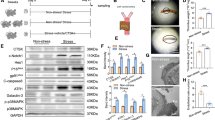Abstract
Objective
To explore the effects of acupuncture on the peripheral serum expression of heat shock protein 70 (HSP70) and tumor necrosis factor α (TNF-α) in rats with cerebral ischemia-reperfusion injury (CIRI).
Methods
In total, 152 Sprague-Dawley (SD) rats were randomly divided into an operated group and a non-operated group according to a random digits table. The operated group included a sham-operated group, a model group and an acupuncture group, whereas the non-operated group consisted of a normal group. Except for the normal group, each group was further divided into 12, 24, 48, 72, 96, and 144 h time points according to different reperfusion times. Eight rats were assigned in each operated group and in the normal group. The rat model of CIRI was established by the thread occlusion method in the model and acupuncture groups. The acupuncture group was treated with electroacupuncture at Baihui (DU20) and Zusanli (ST36) for the required time after successful operation. Blood was sampled to detect the HSP70 and TNF-α content by enzyme linked immunosorbent assay.
Results
The expression of HSP70 protein in the peripheral serum of the experimental groups was higher than that in the normal control group. The peak time in both the model and the sham-operated groups was 12 h, and the peak time in the acupuncture group was 24 h. The expression in the acupuncture group declined to a lower level at 72 h and was lower than that in the model and sham-operated groups (P<0.05). The peak time for the expression of TNF-α protein in the peripheral serum of both the model and the acupuncture groups was 24 h, but the expression in the acupuncture group was lower than the model group. Additionally, the expression of TNF-α in all experimental groups was higher than the normal group (P<0.05).
Conclusions
Acupuncture at DU20 and ST36 in rats attenuated CIRI, which was associated with a reduction in the expression of HSP70 and TNF-α. These results provide clues to acupuncture’s neuroprotective properties. Acupuncture at DU20 and ST36 in rats after CIRI can adjust the expression of HSP70 and TNF-α in the peripheral serum, which might be one of the mechanisms of acupuncture’s attenuation of CIRI.
Similar content being viewed by others
References
China Ministry of Health. China statistical yearbook of public health Beijing: Peking Union Medical College Press; 2013:114.
Tao J, Xue XH, Chen LD, Yang SL, Jiang M, Gao YL, et al. Electroacupuncture improves neurological deficits and enhances proliferation and differentiation of endogenous nerve stem cells in rats with focal cerebral ischemia. Neurol Res 2010;32:198–204.
Li XH, Wang HB, Xu LL, Song XL, Zheng LH, Yu W, et al. Effect of preventive acupuncture and moxibustion at “Guanyuan” (CV4) on the expression of HSP 70 and HSP 70 mRNA in spleen and the contents of serum IL22, TNF2α in menopausal rats. Acupunct Res (Chin) 2009;34:83–88.
Duan LJ, Zhu HY, Li HP. The influence of TNF-α and IL-1β by different eletroacupuncture intensity on acute cerebral ischemia reperfusion in rats. J Xinjiang Med Univ (Chin) 2012;35:604–607.
Longa EZ, Weinstein PR, Carlson S, Cummins R. Reversible middle cerebral artery occlusion without craniectomy in rats. Stroke 1989;20:84–91.
Bederson JB, Pitts LH, Tsuji M, Nishimura MC, Davis RL, Bartkowski H. Rat middle cerebral artery occlusion: evaluation of the model and development of a neurologic examination. Stroke 1986;17:472–476.
Li ZR. Experimental acupuncturology. Beijing: China Press of Traditional Chinese Medicine; 2007:255.
Huang Y, Tang C, Wang S, Lu Y, Shen W, Yang J, et al. Acupuncture regulates the glucose metabolism in cerebral functional regions in chronic stage ischemic stroke patients—a PET-CT cerebral functional imaging study. BMC Neurosci 2012;13:75.
Zhang S, Li G, Xu X, Chang M, Zhang C, Sun F. Acupuncture to point Baihui prevents ischemia-induced functional impairment of cortical GABAergic neurons. J Neurol Sci 2011;307(1–2):139–143.
Cho SY, Kim M, Sun JJ, Jahng GH, Kim HJ, Park SU, et al. A comparison of brain activity between healthy subjects and stroke patients on fMRI by acupuncture stimulation. Chin J Integr Med 2013;19:269–276.
Luo Y, Xu NG, Yi W, Yu T, Yang ZH. Study on the correlation between synaptic reconstruction and astrocyte after ischemia and the influence of electroacupuncture on rats. Chin J Integr Med 2011;17:750–757.
Zhou YC, Wu XG, Xiao YC. Effects of electroacupuncture at “Zusanli” (ST36) and “Neiguan” (PC6) on expression of GAP-43 in cerebral infarction rats. Chin Acupunct Moxibust (Chin) 2011;31:55–59.
Cheng J, Li ZR, Zhu Y, Shen MH, Jing DD, Li C, et al. Effects of electroacupuncture on expression of calmodulin in the hippocampus of rats with cerebral ischemia-reperfusion injury. Chin Acupunct Moxibust (Chin) 2011;31:1015–1019.
Zheng Z, Kim JY, Ma H, Lee JE, Yenari MA. Anti-inflammatory effects of the 70 kDa heat shock protein in experimental stroke. J Cereb Blood Flow Metab 2008;28:53–63.
Kim N, Kim JY, Yenari MA. Anti-inflammatory properties and pharmacological induction of Hsp70 after brain injury. Inflammopharmacology 2012;20:177–185.
Aneja R, Odoms K, Dunsmore K, Shanley TP, Wong HR. Extracellular heat shock protein-70 induces endotoxin tolerance in THP-1 cells. J Immunol 2006;177:7184–7192.
Kim N, Kim JY, Yenari MA. Anti-inflammatory properties and pharmacological induction of Hsp70 after brain injury. Inflammopharmacology 2012;20:177–185.
Giffard RG, Han RQ, Emery JF, Duan M, Pittet JF. Regulation of apoptotic and inflammatory cell signaling in cerebral ischemia: the complex roles of heat shock protein 70. Anesthesiology 2008;109:339–348.
Author information
Authors and Affiliations
Corresponding author
Additional information
Supported by the National Natural Science Foundation of China (No. 81072889) and Special Funding for Research in Health Industry of the Ministry of Science and Technology (No. 200902004-12)
Rights and permissions
About this article
Cite this article
Xu, H., Sun, H., Chen, Sh. et al. Effects of acupuncture at Baihui (DU20) and Zusanli (ST36) on the expression of heat shock protein 70 and tumor necrosis factor α in the peripheral serum of cerebral ischemia-reperfusion-injured rats. Chin. J. Integr. Med. 20, 369–374 (2014). https://doi.org/10.1007/s11655-014-1800-z
Received:
Published:
Issue Date:
DOI: https://doi.org/10.1007/s11655-014-1800-z




